
Original Link: https://www.anandtech.com/show/2024
NVIDIA's Latest Drivers: The 90 Series Control Center
by Josh Venning on June 9, 2006 8:50 AM EST- Posted in
- GPUs
Introduction
Any piece of computer hardware is more or less useless without software drivers that allow it to work with the rest of the system. Anyone who has ever installed something like a webcam or some other obscure device knows that without the little disk or CD that comes with it, the device just won't work. Drivers for many devices are very easy to install and require little or no further tweaking, but not so with more complex hardware like graphics solutions.
A driver is code written to allow a piece of hardware such as a graphics card to be recognized and used by the system. For many computer peripherals, simply installing the driver is enough, but some parts require that the driver have an interface which allows users to tweak certain settings according to their needs. Both NVIDIA and ATI have unique driver interfaces, and it can be a bit confusing for those switching from one brand to the other with their graphics card upgrades. While both manufacturers have access to many of the same settings, finding a certain setting and navigating the interface can be more or less difficult with one than the other, depending partly on the experience of the user.
We've seen that in the past NVIDIA's ForceWare drivers have generally been better than ATI's Catalyst in the extent of their control over a wide range of graphical settings. However, ATI has been working to improve their drivers, and the Catalyst Control Center is an intuitive .NET based interface which is easy to use, and offers control over a wide range of settings as well. Naturally, users will have their own preferences, and while both have their positives and negatives, they each offer adequate control over most aspects of the drivers.
Initially, ATI's Catalyst Control Center suffered from some major performance problems which negatively affected usability despite the "new and improved" interface. Since its introduction, performance has gotten much better and the user interface refinements are better able to shine through without significantly annoying those who don't require the assistance of a real-time preview. It has taken a while for ATI's new UI to get to this point, and we are very interested in determining whether or not NVIDIA has learned from ATI's initially rocky attempt at completely redesigning their driver control panel.
For this article, we will be taking a look at the new 90 series video drivers from NVIDIA, specifically its user interface features and how they differ from the current version. The style has been changed significantly and looks to be more "Vista inspired" in its interface. This looks like it may cause problems for those used to NVIDIA's old style of navigation, but more on that later. For now, here is an overview of the 90 series Control Center by NVIDIA as well as screen shots and info on each of the menu sections and what settings are available under each.
Driver Menu
 |
| Click to enlarge |
The settings in the 90 series drivers are laid out in three sections displayed clearly on the main menu. We can see how much more "windows-like" the interface is, particularly with the help options on the left, and a section under that to list recently accessed settings for easier navigation. Note that we used the Coolbits registry tweak to allow access to certain advanced settings like overclocking.
3D Settings
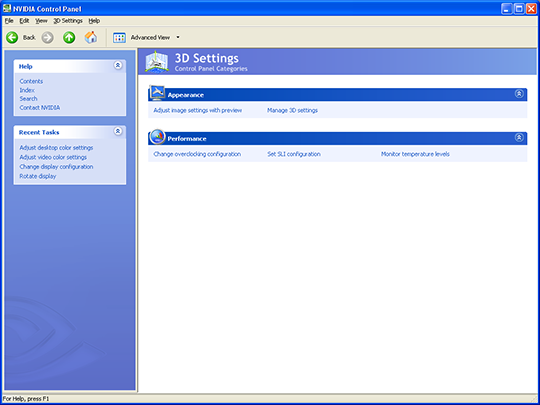 |
| Click to enlarge |
Under the first selection, we see what options are available under 3D Settings, split into two sections, appearance and performance.
Adjust Image Settings With Preview
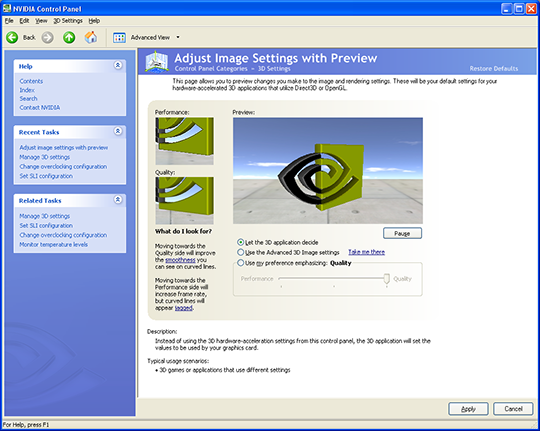 |
| Click to enlarge |
This section gives a very nice 3d rendered live preview to allow for intuitive graphics tweaking, much like ATI implemented in their current Catalyst Control Center interface. One notable difference between ATI's preview and NVIDIA's however is that the 3D preview pops up without any noticeable lag, while ATI's can take several seconds to render once selected.
Manage 3D Settings
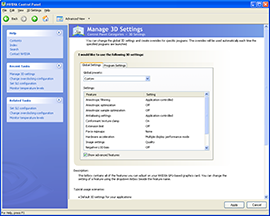 |
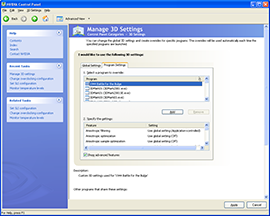 |
| Click to enlarge | |
This section is basically the same as the old control panel's application profiles under the "Performance and Quality" section.
Change Overclocking Configuration
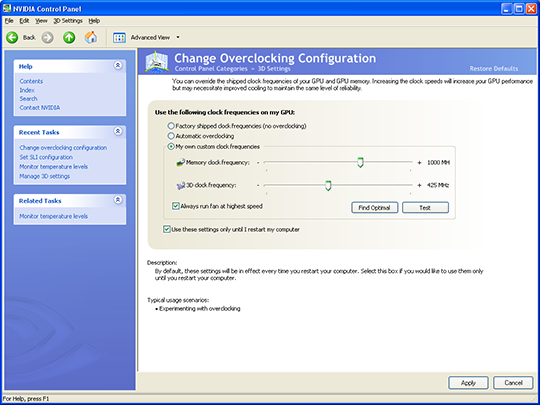 |
| Click to enlarge |
Here we see a slightly simplified overclocking menu to manually set your core and memory clock speeds. The earlier 91.27 Beta drivers didn't allow the option to save the settings, and we're glad to see that has been fixed with the official 91.31 Beta release.
Set SLI Configuration
| Click to enlarge |
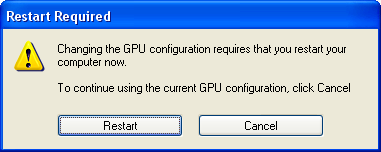 |
SLI can be enabled/disabled if appropriate cards are installed through this panel. Oddly enough, a reboot was required to enabled SLI on at least one of our systems, which was not necessary with previous drivers. This only happened once, however, so we're not sure what triggered the reboot dialog.
Monitor Temperature Levels
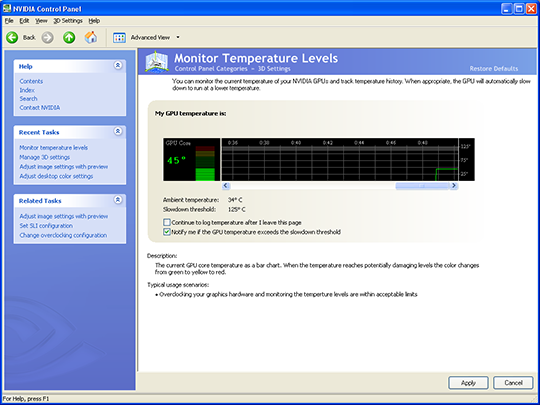 |
| Click to enlarge |
Something very interesting about this new NVIDIA driver is that it offers much more extensive temperature monitoring, even going so far as to allow you to log your heat levels while running programs with the driver control panel closed. This is good for those who for whatever reason want to keep close tabs on the heat level of their NVIDIA solutions. Such functionality was previously available through the separate nTune utility, but it's nice to see it integrated directly into the new drivers.
The driver will log your heat levels for the last hour, and an option can be selected to notify if the heat levels have exceeded a certain threshold as well. This section shows potential, but unfortunately, logging your heat levels while gaming causes a significant performance hit, and we experienced about a 10 fps loss in Quake 4 with this option turned on (62.7 verses 71.0 fps). This means that while it won't be practical to leave the heat logging option turned on all the time, it is still a good diagnostic tool for purposes such as overclocking and monitoring cooling conditions.
Display
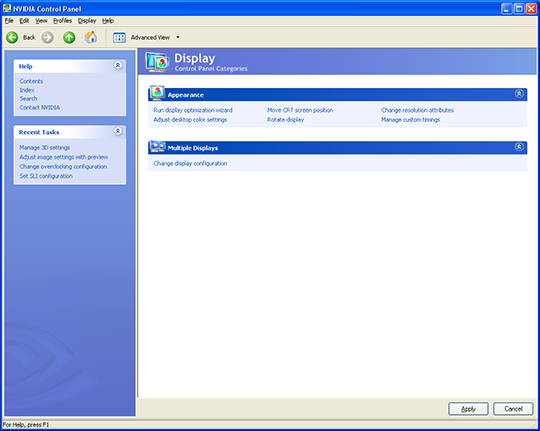 |
| Click to enlarge |
Under the display menu, we see a section for appearance, and multiple displays.
Display Optimization Wizard
This item offers a wizard to help you optimize your display. The following nine screenshots show the steps of the wizard, though the flat panel display calibration step is skipped for non-flat panel displays. (We would recommend choosing flat panel regardless, if you want to use the test pattern to try and align the image on a CRT display.)
 |
 |
 |
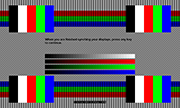 |
 |
 |
 |
 |
 |
| Click to enlarge | ||
First you get the introduction, followed by your display(s). If you choose one of the displays as being a flat panel, you get an extra two screens for flat panel optimization. Next is a screen for color temperature. We found this screen to be a little confusing, but basically what it's saying is that you should use the controls of your display to set the temperature to what you find appropriate. That's not particularly helpful, and the text could be better at explaining what you're supposed to do. Telling you to "set the color temperature to the value that most accurately represents white" when the majority of the screen is black is also less than useful.
After another helpful preparation screen, you get to optimize the brightness and gamma levels of your display. It should be noted that 100% contrast setting is not always ideal on every display. The gamma correction page is also a bit confusing, as the boxes don't actually slide left/right; instead, you click and drag and the color bars change while your mouse cursor moves and the white box remains in the center of the display. The end result of the display optimization wizard is that some people will get slightly better colors for their display, but it's not the same as professional color calibration tools. Still, it's better than nothing.
Move CRT Screen Position
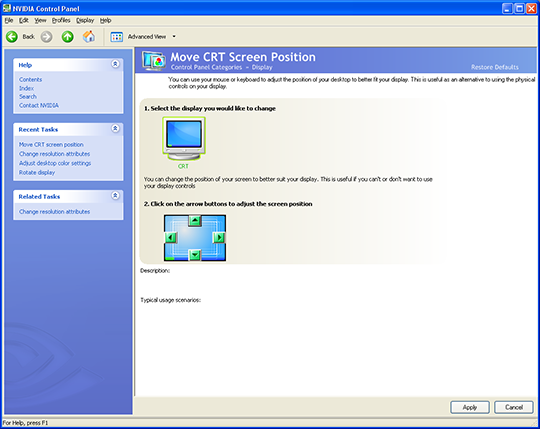 |
| Click to enlarge |
Change Resolution Attributes
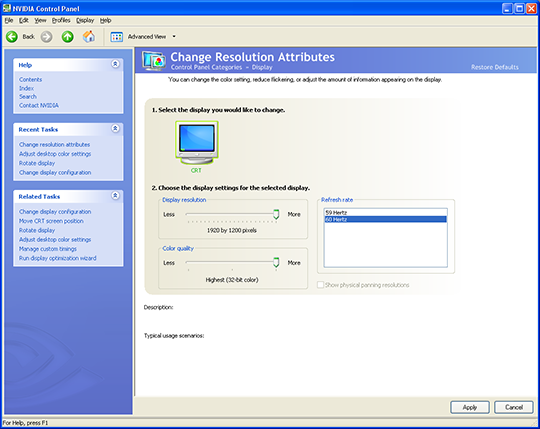 |
| Click to enlarge |
Here we see a simple menu to change screen resolution and color quality, as well as the refresh rate.
Adjust Desktop Color Settings
 |
| Click to enlarge |
This section gives you control over several color settings to fine tune your display image.
Rotate Display
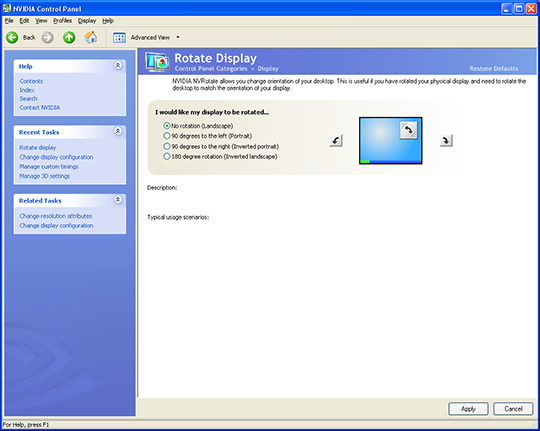 |
| Click to enlarge |
Change Display Configuration
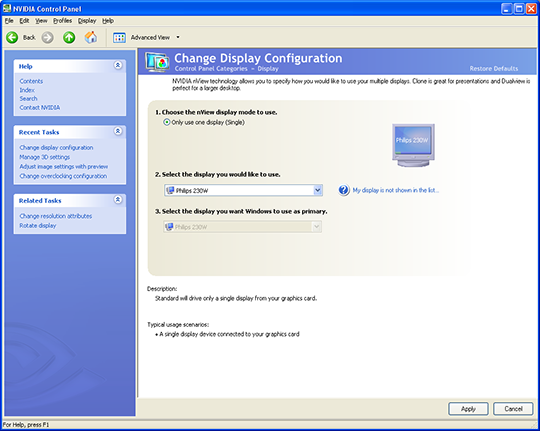 |
| Click to enlarge |
This section is a straightforward menu that allows you to configure your display configuration if you use multiple displays. Similar functionality is present in the standard Windows Display dialog, so this is basically redundant.
Manage Custom Timings
 |
| Click to enlarge |
Having become accustomed to the custom resolution options with the previous control panel, the new version doesn't seem to have all of the same features. For example, in the old NVIDIA interface, there was an easy-to-use dialog that allowed customization of HDTV output signals, including a section for overscan correction, a.k.a. underscan. That appears to be completely missing from the new control panel, though this may be more a case of their Beta nature than a conscious decision on NVIDIA's part. Here are some images showing the new interface as well as the missing overscan correction UI.
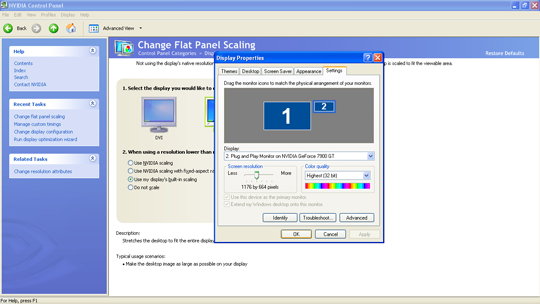 |
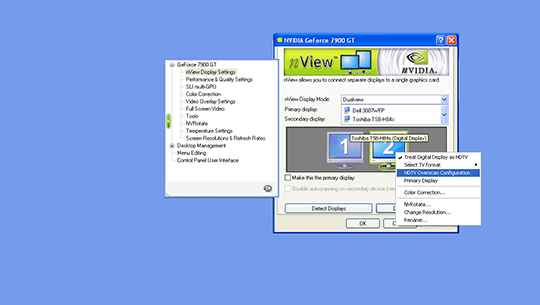 |
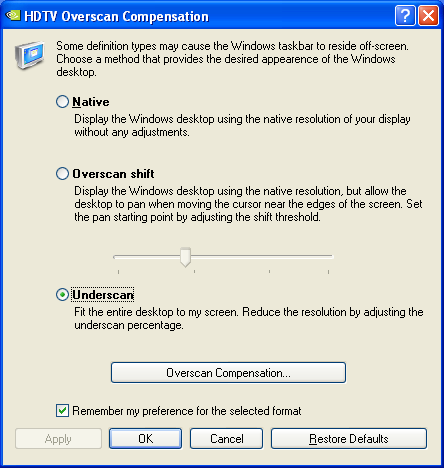 |
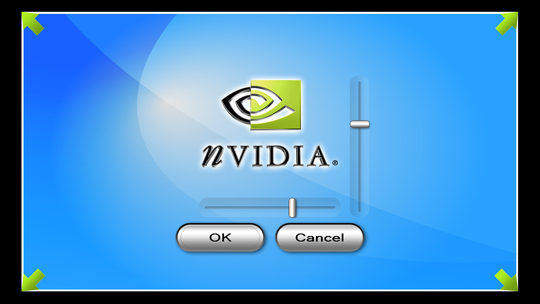 |
| Click to enlarge |
What's worse is that the custom resolutions simply don't seem to work properly with the new UI. You can see the first screen which used the new UI to create a custom resolution of 1176x664. Everything seems to be in order, but then why is the screenshot still 1280x720? Try as we might, we could not get the customized 720p underscan resolution to work with the new UI. Switching back to the old interface remedies the problem in short order. (The black border on the last image represents the area on a Toshiba 46H84 HDTV that isn't visible, in case you were wondering.)
Video and Television Settings
 |
| Click to enlarge |
 |
 |
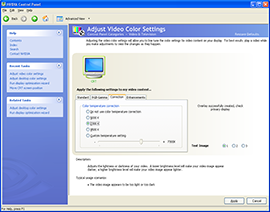 |
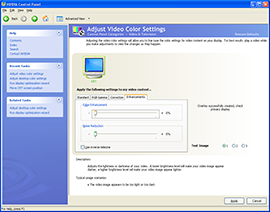 |
| Click to enlarge | |
The third menu selection only has one option available in it, adjust video color settings. This basically offers the same color settings that we saw for the display color settings, only for video content. Video overlay mode takes a different route through the drivers, and this allows you to tune your color output separately. This functionality has been present in both ATI and NVIDIA drivers for quite some time, of course.
Final Words
The UI for a graphics driver (or any software for that matter) should strive for a certain level of functionality and usability for its user. There should be access to all the necessary options while still being intuitive and easy for users to navigate. This is the basic ideal requisite for all driver interfaces, and it is our experience that NVIDIA's graphics drivers over the years have done just that. One issue that has plagued ATI's driver interface is the issue of startup time and lag after clicking on selections in the menu. While we are only talking seconds here, this can be pretty frustrating, and gives the interface a very "clunky" feel over NVIDIA's, which don't have this problem.
Change is necessary as technology evolves, and it's sometimes difficult dealing with an interface we aren't used to even when it is generally accepted as better than the previous version (think Windows and the 95 and XP UI upgrades). Whether or not this driver will be better or worse than the previous one is open to debate, but this is something we are taking into account when critiquing the 90 Series ForceWare update. Putting aside our initial prejudices against the new interface however, there are some differences from the old version that need to be addressed.
Some advanced settings that were available using Coolbits or NVTweak with the classic interface are no longer accessible, which could cause some problems for users needing to access them. Fortunately, these are still able to be tweaked by choosing the option to go back to the old interface so it looks to be more of an inconvenience rather than a detriment for those using the driver. The things that appear left out include Display Mode Timing, Refresh Rate Overrides, Additional Direct3D Settings, and Additional Information (VESA BIOS Details). Some of these are serious omissions for some, as mentioned earlier. HDTV use for many people requires the ability to fine tune the resolution, and until this is corrected you will need to revert to the classic UI.
It's good that NVIDIA has left the option to go back to "classic" mode over the new one, but it defaults to the new mode when installed. Figuring out how to switch back can be confusing initially, but it turns out that all you need to do is enter the View menu and select "Switch to Classic Interface." It would be helpful if this option were placed more prominently, perhaps under one of the Main Menu icons. You can also switch to the classic UI through the "Advanced" dialog off the standard Windows Display Settings interface, though that's even less intuitive.
The new driver interface has a couple of solid positives going for it as it stands, and these should be noted. Keeping access to the classic mode could technically be seen as one, but there's no doubt the revamped heat section is a plus. The real-time preview mode may also be useful for newer users, though most enthusiasts will simply find it to be window dressing that gets in the way. Being able to log heat levels while benchmarking or playing games is a nice thing for enthusiasts and overclockers who wish to keep track of temperature over time. Intel, ATI, S3, and other graphics hardware designers would do well to adopt a similar option for their own drivers. The new drivers also offer integration with NVIDIA's chipset drivers, providing a common interface, and the latest nTune 5.0 software also (partially) integrates with the new UI and allows control over many aspects of the motherboard that were previously only accessible by rebooting and entering the CMOS menus. Finally, all of the screens do an admirable job of providing context sensitive tips at the bottom that explain what each setting changes.
That said, NVIDIA needs to improve on their new interface even further. As it stands, the menus look Vista-like, but act a lot more like the current windows explorer. The issue is in the branching sections: it is difficult to immediately find which section the particular setting you are looking for will be under. Whereas the old way has all of the settings listed right under the top level menu options, the 90 Series driver's "sections within sections" style requires users to hunt around for some items. This could be remedied by having the subsections listed and accessible via the main menu (as Vista's control panel will be) in each of the main icons. At any rate, it needs to be clear which options are contained within each category or even the novice users NVIDIA is attempting to cater to will become frustrated while attempting to change even the simplest settings.
To summarize, these are the main things we would like to see NVIDIA incorporate with the 90 series drivers:
- Make the interface more easily navigable; it should be easier to find certain specific settings from the main menu.
- Provide access to more driver settings; at the very least, provide access to options that were available in the previous driver version (i.e. refresh rate overrides).
While the NVIDIA driver interface has changed dramatically from the previous version, it makes sense for NVIDIA to revamp the design to better resemble the Vista interface. If incorporated correctly, this kind of interface could be potentially very useful, but as it stands, NVIDIA has some tweaking of their own to do before the 90 series control center can live up to its potential. Of course, offering a Vista-like interface on top of XP is not really necessary, but some people might like the new UI and giving users the choice of which interface to use is definitely appreciated. We only hope that the classic control panel doesn't go the way of ATI's old control panel - while ATI technically continues to offer their old UI, CrossFire users are required to upgrade to CCC if they want to actually take advantage of their dual GPUs.
Given the Beta nature of the current 90 series drivers, we can't draw too many final conclusions. Hopefully, our above concerns will be addressed, and overall the new UI seems to be shaping up nicely. There will certainly be hold-outs that like the older interface, and some of us will be among them pending a few hopefully easy fixes. In the mean time, we look forward to seeing what future refinements NVIDIA will offer.







